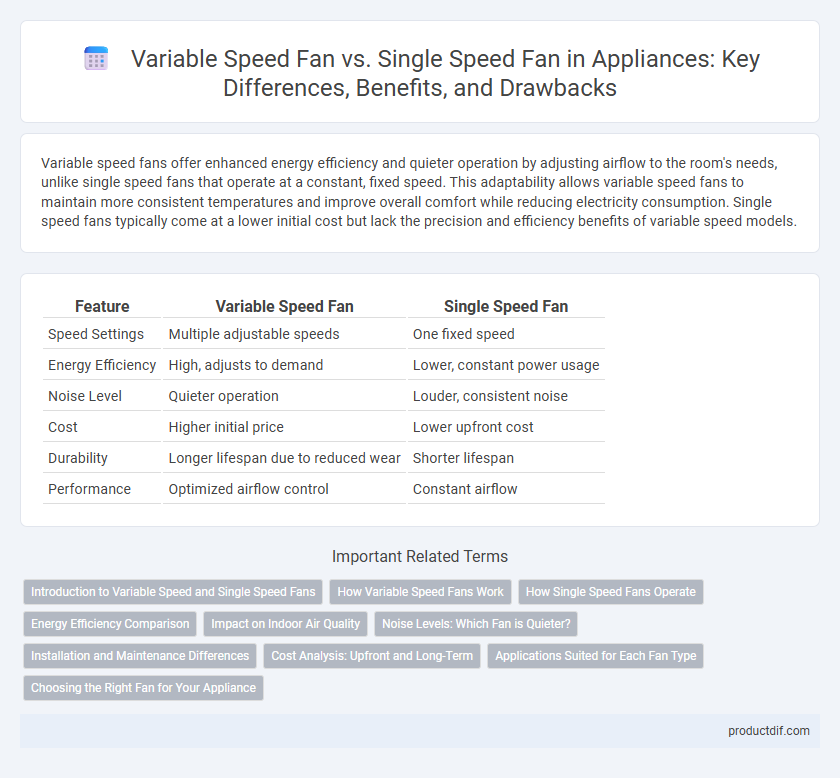Variable speed fans offer enhanced energy efficiency and quieter operation by adjusting airflow to the room's needs, unlike single speed fans that operate at a constant, fixed speed. This adaptability allows variable speed fans to maintain more consistent temperatures and improve overall comfort while reducing electricity consumption. Single speed fans typically come at a lower initial cost but lack the precision and efficiency benefits of variable speed models.
Table of Comparison
| Feature | Variable Speed Fan | Single Speed Fan |
|---|---|---|
| Speed Settings | Multiple adjustable speeds | One fixed speed |
| Energy Efficiency | High, adjusts to demand | Lower, constant power usage |
| Noise Level | Quieter operation | Louder, consistent noise |
| Cost | Higher initial price | Lower upfront cost |
| Durability | Longer lifespan due to reduced wear | Shorter lifespan |
| Performance | Optimized airflow control | Constant airflow |
Introduction to Variable Speed and Single Speed Fans
Variable speed fans adjust airflow by varying motor speed, providing precise temperature control and energy efficiency in appliances. Single speed fans operate at a fixed speed, delivering consistent airflow but often consuming more power and producing more noise. Variable speed technology enhances comfort and reduces energy costs, while single speed fans offer simplicity and reliability.
How Variable Speed Fans Work
Variable speed fans use advanced motors controlled by electronic circuits to adjust fan speed based on real-time environmental conditions. This technology allows for precise airflow regulation, optimizing energy efficiency and reducing noise levels compared to single speed fans. By continuously modulating motor speed, variable speed fans maintain consistent comfort while minimizing power consumption.
How Single Speed Fans Operate
Single speed fans operate with a fixed motor speed, running at one constant rate regardless of the airflow demand. These fans turn on and off as needed but cannot adjust speed to save energy or optimize airflow. As a result, single speed fans tend to consume more electricity and may produce higher noise levels compared to variable speed fans.
Energy Efficiency Comparison
Variable speed fans significantly enhance energy efficiency by adjusting airflow to meet precise cooling demands, reducing power consumption compared to single speed fans that operate at a constant rate. Studies indicate that variable speed fans can save up to 30-40% more energy, leading to lower utility bills and reduced environmental impact. Advanced technologies in variable speed motors enable quieter operation and longer appliance lifespan, further supporting energy-saving goals.
Impact on Indoor Air Quality
Variable speed fans enhance indoor air quality by adjusting airflow based on real-time air quality sensors, effectively reducing allergens and pollutants. Single speed fans operate at a fixed rate, often leading to uneven ventilation and potential buildup of contaminants. Energy-efficient variable speed fans promote consistent air circulation, improving filtration and humidity control for healthier indoor environments.
Noise Levels: Which Fan is Quieter?
Variable speed fans operate at adjustable speeds, significantly reducing noise levels by running slower during low-demand settings compared to single speed fans that run constantly at full power. The ability to modulate fan speed minimizes overall sound output, making variable speed fans quieter in typical home appliance applications. Single speed fans tend to generate consistent, louder noise due to their fixed operational speed without modulation.
Installation and Maintenance Differences
Variable speed fans often require more complex installation due to advanced electronic controls and compatibility with smart thermostats, while single speed fans feature straightforward wiring and simpler setup. Maintenance for variable speed fans may involve software updates and occasional sensor checks to ensure optimal performance, whereas single speed fans typically need routine cleaning and basic mechanical inspections. Choosing between the two depends on the user's comfort with technology and desired energy efficiency.
Cost Analysis: Upfront and Long-Term
Variable speed fans typically have a higher upfront cost than single speed fans due to advanced motor technology and control systems. Over time, variable speed fans offer significant energy savings and reduced wear, lowering long-term operating costs and maintenance expenses. Single speed fans, while cheaper initially, often result in higher electricity bills and more frequent repairs, increasing total ownership costs.
Applications Suited for Each Fan Type
Variable speed fans excel in applications requiring precise airflow control, such as HVAC systems, air purifiers, and energy-efficient appliances, where adjustable speeds optimize comfort and conserve energy. Single speed fans are well-suited for constant airflow needs in devices like basic room fans, exhaust fans, and some industrial equipment, offering simplicity and reliable performance at a fixed speed. Choosing the appropriate fan type depends on the specific application demands for airflow variability, energy efficiency, and noise control.
Choosing the Right Fan for Your Appliance
Choosing the right fan for your appliance depends on efficiency and noise preferences; variable speed fans offer adjustable airflow and energy savings by operating at different speeds, which enhances performance in appliances like HVAC systems. Single speed fans run at a constant speed, providing consistent airflow but often consuming more energy and generating higher noise levels. Selecting a variable speed fan improves temperature control and reduces electricity costs, making it ideal for modern, energy-conscious appliances.
Variable Speed Fan vs Single Speed Fan Infographic

 productdif.com
productdif.com